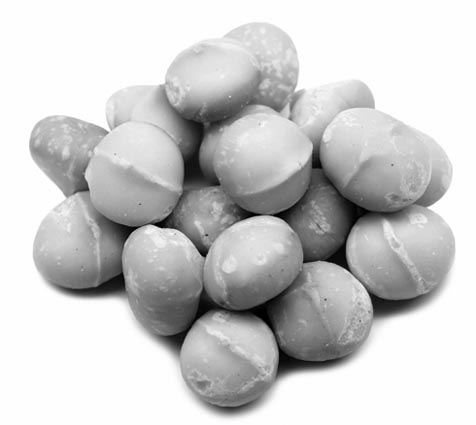Growing Macadamias in S.B.
Australian Nut

It’s no secret by now that many plants that are successful in Southern California hail from Australia. One that you might not have thought to consider for your home garden is the macadamia nut. These glossy green-leaved evergreens are easy to grow, requiring similar amounts of water and care as citrus and avocado. With their dangling clusters of small white flowers, they are handsome and serve ornamentally as well as providing some of the tastiest nuts around. Trees grow slowly to 30 to 40 feet in height.
There are two species of macadamias and several hybrids and selections available, although you may have to search out a nursery specializing in exotic fruits to find much of a choice. The smooth-shell macadamia, Macadamia integrifolia, is more suitable for the mildest coastal regions, while the rough-shell macadamia, M. tetraphylla, is better for inland sites. Named hybrids will perform better and more reliably than seed-grown plants, especially if you want the largest crops. It isn’t necessary to plant more than one to achieve pollination, but many growers have found that planting more than one variety can increase your chances for larger harvests.
Now is a good time to plant macadamias so they have the long spring and summer months to establish good root systems. If your soil is moderately fertile already, you can dispense with additional fertilizers and keep them healthy with consistent mulching to encourage nutrient cycling. Usually disease- and pest-free, some even claim that they are resistant to oak root fungus, making them essentially care-free. Careful pruning to train a scaffold of strong limbs is recommended as their wood can be somewhat weak.
Macadamia nuts are among the most expensive and delicious, so growing your own can save on your food budget. Harvesting the nuts will depend entirely on which variety you plant. Varieties with M. tetraphylla as a parent will produce seeds over several months. All that is required is to pick them up as they fall to the ground, usually beginning in fall or winter. Some of the named varieties include ‘Cate,’ ‘Elymba,’ ‘Burdick’, and ‘Fenton.’ M. integrifolia cultivars include many with Hawaiian names, a testament to their popularity there. Look for ‘Kau,’ ‘Keaau,’ ‘Mauka,’ and one not following this rule, ‘Purvis.’ The cultivar ‘Beaumont’ is a hybrid between the two species and holds its nuts very tightly, even after they are ripe. The nuts must be stripped off the tree by hand in early March. For the others, just make weekly visits to the tree and pick up those that have fallen. Don’t leave them on the ground for long or they may be damaged by mold. Most named varieties will begin to produce nuts in three to five years. After about 10 years, the trees produce 30 to 50 pounds of nuts.
Once you have nuts, care should be taken to dry them slowly to produce the best flavor. Remove the outer husk (using pliers if they stick tightly), spread them on wire racks, and let them dry in the shade for two to three weeks. After the initial drying, complete the process with very low heat, such as you might encounter near a heat register or in the oven at a very low temperature. At no time should the temperature exceed 115 degrees. In a regular oven on the lowest setting this will take about 12 hours, but at lower temperatures, it could take three days. Test a few during the process to know when they are done. If they are still chewy and not crisp, continue the drying. Nuts can be kept at this point still in their shells or cracked and nutmeats stored in airtight containers in the refrigerator or freezer. Macadamia nuts are very tough to crack, but special nutcrackers have been designed to accomplish this. I know one person who used a regular screw vice in his shop to get at their buttery goodness.
Macadamias are high in fat, but most of it is mono-unsaturated. In fact, like olive oil, they contain oleic acid, which is thought to be helpful in lowering cholesterol. So enjoy them in moderation with a clear conscience.
Here are a few growers in Southern California:
• Papaya Tree Nursery in Granada Hills; papayatreenursery.com.
• J. D. Andersen Nursery in Fallbrook; jdandersen.com/index.html.
• California Tropical Fruit Trees in Vista; tropicalfruittrees.com.
And here are some nutcrackers designed just for macadamias:
• Bono Macs of Hawaii; users.maui.net/~bonomacs.
• The Ultimate Macadamia Nutcracker from the California Macadamia Nut Growers Cooperative; macnuts.org.



